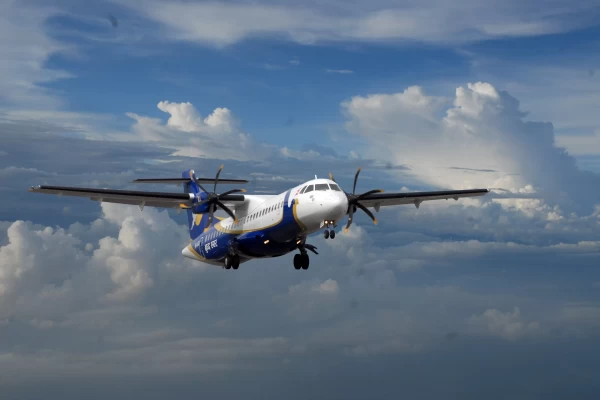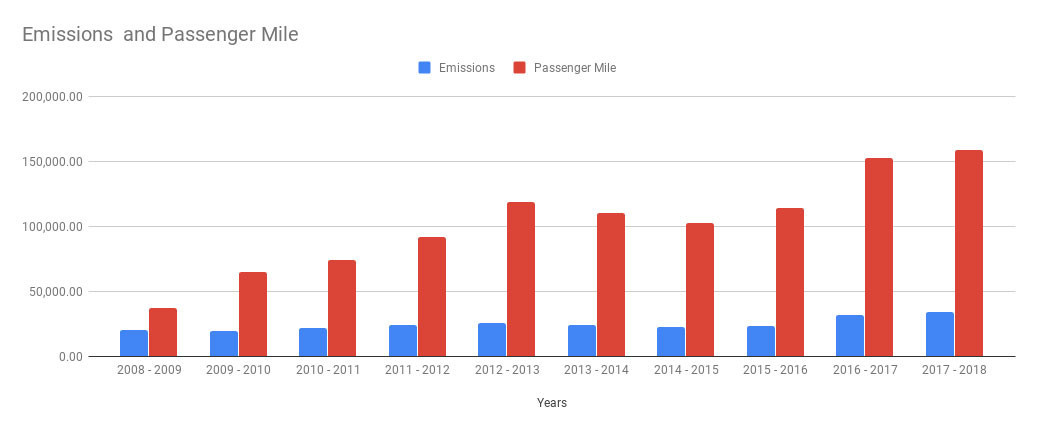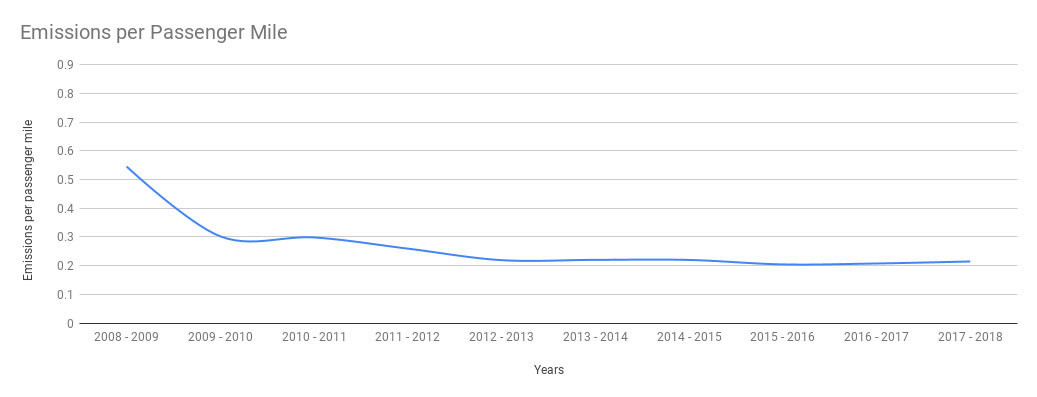Environmental Impact of Aviation & Buddha Air's Approach

All energy production using combustion emits carbon dioxide. This includes driving vehicles, electricity production, heating, etc. It is also produced through the decomposition of organic matter in soils under oxidizing conditions.
Global warming is a phenomenon believed to occur as a result of the build-up of carbon dioxide and other greenhouse gases. Many scientists have identified it as a major global environmental threat.
CO2 is released into the atmosphere in a ton of ways. The largest source of natural carbon emissions is the exchange of carbon dioxide between oceans and the atmosphere. Animals and plants also emit CO2 through the process of respiration (breathe in oxygen, breathe out CO2). When these plants and animals decompose, organisms within the soil respire to produce energy and emit more CO2 into the atmosphere.
Due to human activities, the atmospheric concentration of carbon dioxide has been rising extensively since the Industrial Revolution and has now reached dangerous levels not seen in the last 3 million years. Human sources of carbon dioxide emissions are much smaller than natural emissions but they have upset the natural balance that existed for many thousands of years before the influence of humans.
Someone flying from London to New York and back generates roughly the same level of emissions as the average person in the EU does by heating their home for a whole year.
87% of all human-produced carbon dioxide emissions come from the burning of fossil fuels like coal, natural gas, and oil. The remainder results from the clearing of forests and other land-use changes (9%), as well as some industrial processes such as cement manufacturing (4%).
The transportation sector is the second-largest source of anthropogenic carbon dioxide emissions. Transporting goods and people around the world produced 22% of fossil fuel-related carbon dioxide emissions in 2010. This sector is very energy-intensive and it uses petroleum-based fuels (gasoline, diesel, kerosene, etc.) almost exclusively to meet those needs.
Road transport and marine shipping account for 72% and 14% of this sector's carbon dioxide emissions respectively.
Global aviation accounts for 11% of all transport carbon dioxide emissions. International flights create about 62% of these emissions with domestic flights representing the remaining 38%. Over the last 10 years, aviation has been one of the fastest-growing sources of carbon dioxide emissions. Aviation is also the most carbon-intensive form of transportation, so its growth comes with a heavy impact on climate change.
Aircraft engines emit heat, noise, and gases which contribute to climate change and global dimming. Airplanes emit particles and gases such as carbon dioxide (CO2), water vapor, hydrocarbons, carbon monoxide, nitrogen oxides, sulfur oxides, lead, and black carbon which interact among themselves and with the atmosphere.
Comprehensive research shows that despite anticipated efficiency innovations to airframes, engines, aerodynamics, and flight operations, there is no end in sight, even many decades out, to rapid growth in CO2 emissions from air travel, due to projected continual growth.
Even though there have been significant improvements in fuel efficiency through aircraft technology and operational management, these improvements are being continually eclipsed by the increase in air traffic volume.
The Carbon Offsetting and Reduction Scheme for International Aviation, or CORSIA, aims to stabilize CO2 emissions at 2020 levels by requiring airlines to offset the growth of their emissions after 2020.
Aviation became the first global industry to limit its carbon footprint as International Civil Aviation Organization (ICAO) approved a plan to offset carbon emissions growth from international flights after 2020.
Buddha Air Approach
Having gone through all the statistics on Carbon Dioxide Emissions published by international agencies and our commitment to offset it in the long run, we have started our sincere efforts way back in 2008 when we decided to introduce fuel-efficient and environment-friendly ATR aircraft which is a milestone in this effort.
The rapid growth of air travel in recent years contributes to an increase in total pollution attributable to aviation and emits tons of additional carbons which is a natural phenomenon but the million-dollar question is whether all stakeholders are able to transport with fewer emissions per passenger mile.
The metric used for CO2 emissions is kilograms of emission per passenger mile and this is significantly used in the aviation sector for its effectiveness which has been linked to global warming.
Emissions of passenger aircraft per passenger mile vary extensively because of different factors such as the size and type of aircraft, altitude and the percentage of the passenger on a particular flight and the distance of the journey, and the number of stops en route.
CO2 emissions in air travel vary by length of flight, ranging from 0.251 Kg CO2 per passenger mile to 0.143 Kg CO2 per passenger mile, depending on the flight distance, assumed to be the global standard of carbon emissions although different researchers and authors might have slightly different opinions.
Air travel – short haul (<300 miles) – 0.251 Kg CO2 per passenger mile
Air travel – medium haul (>=300 <2300 miles) – 0.143 Kg CO2 per passenger mile
Air travel – short haul (>=2300 miles) – 0.167 Kg CO2 per passenger mile
(Air Travel factors from 2015 Guidelines to Defra / DECC's GHG Conversion Factors for Company Reporting. Version 1.0 July 2015)
Buddha Air CO2 Emission Per Passenger Mile
|
Fiscal Yr |
Fuel uplift Ltrs |
Passenger Miles (PM) '000' |
Emission / Passenger Mile |
|
2008-09 |
7,999,494 |
64,871 |
0.5453 |
|
2009-10 |
7,717,430 |
65,175 |
0.3022 |
|
2010-11 |
8,698,048 |
74,365 |
0.2985 |
|
2011-12 |
9,400,037 |
92,397 |
0.2596 |
|
2012-13 |
10,208,267 |
118,695 |
0.2195 |
|
2013-14 |
9,533,258 |
110,341 |
0.2205 |
|
2014-15 |
8,736,057 |
102,556 |
0.2202 |
|
2015-16 |
9,252,667 |
114,737 |
0.2047 |
|
2016-17 |
12,479,656 |
153,188.52 |
0.2079 |
|
2017-18 |
13,386,025 |
158,966.85 |
0.2149 |
|
2018-19 |
15773327 |
182456 |
0.1900 |
|
2019-20 |
12487017 |
154750 |
0.1524 |


From our own perspective, we have been able to reduce it to quite a significant level with collaborative work with our loan provider, a reputed renowned international agency in 2008 where the figure stands at 0.5453 Kg CO2 emission per passenger mile to 0.1524Kg CO2 emissions per passenger mile in the year 2019-20 and the loan was duly approved after going through all our mechanisms, approach and commitment in this field.
It is quite obvious from the figures above regarding our continuous and sincere commitment to offset Carbon and contribution to the environment. The gradual decrease in carbon emissions per passenger mile is only possible due to fuel-efficient and environment-friendly ATR aircraft which constitute 80% of our fleet capacity right now.
ATR has a keen sense of environmental responsibility and strives to minimize the environmental impact of the delivered products and services. The high-tech engines and propeller efficiency of ATR aircraft ensure airlines an unrivaled fuel efficiency and a remarkably low noise signature, thus securing exceptional environmental performance.
Besides that, we have been monitoring every flight through our Flight Data Monitoring Systems for the effective handling and efficiency of all our flights to make sure that minimum fuel is burned for less emission of CO2.
Improvement in Air Traffic Management and other operational procedures could reduce aviation fuel burn by between 8% and 18%. The large majority (6% to 12%) of these reductions come from ATM movements which will be fully implemented in the years to come with significant contributions from the airport authorities.
